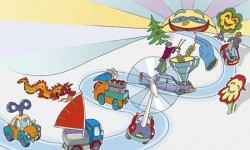An alternative reality check
Carmakers around the world may be arch competitors, but they have one thing in common. They are all racing to develop economically viable vehicles that either use less gas or run on alternative fuels.
In the United States, Europe and, increasingly, China, environmentally conscious consumers, government regulators and institutions are pushing for automobiles that pollute less in light of the mounting pressure to reduce the amount of carbon dioxide released into the atmosphere, considered by many experts to be the cause of global warming.
In February 2007, the European Commission proposed binding rules that would require carmakers to reduce carbon dioxide emissions for new cars to 130 grams per kilometre by 2012. Previously, there were voluntary reductions calling for 140 grams, which were never met.
“The EU car industries are at the core of our econ-omies,” says José Manuel Barroso, president of the European Commission, in defence of the proposal. “By positively taking up the climate change challenge, carmakers will preserve and enhance their competitiveness in the long term.”
In the US, both Congress and the Senate are laying the groundwork for legislation that would require carmakers to increase the average fuel efficiency of their cars, SUVs and vans to 6.72 litres per 100 km by 2020, an decrease of about 1.83 litres per 100 km from current fuel levels. The current fuel economy standard for cars, 8.55 litres per 100 km, has not changed since 1983.
And carmakers, long seen as environmental villains, are answering with a wave of new and innovative car propulsion systems based on ethanol, biogas, hydrogen, battery power and hybrid technologies (see sidebar). While many of these cars are already in production, their costs often outweigh their benefits.
But it is China, with the help of Western carmakers, that is pioneering the use of alternative fuels in cars.
China’s vehicle market is now the second largest in the world after the US by sales, accounting for about 7 million cars sold in 2006, according to the Research and Markets consulting firm, representing an increase of 27 percent over 2005. In the first two months of 2007, the market grew by 34 percent compared with the same period in 2006.
This stunning growth in automobile ownership in China represents a burgeoning middle class that can increasingly afford luxury goods such as cars. According to Research and Markets, per capita GDP in China has risen from 1,000 US dollars in 1991 to more than 7,600 US dollars in 2006.
Concerned about rising levels of air pollution and increased dependence on imported oil, China has already imposed more stringent fuel economy standards than the US, although not as strict as those in Europe.
Cars will consume 138 million tonnes of oil in China annually by 2010, accounting for 43 percent of the nation’s total demand, according to a report from the State Council Development Research Centre, a Chinese government think tank. This will rise to 57 percent by 2020 because of the growing number of vehicles in China. In Beijing alone, 1,000 new cars hit the road every day.
On 4 July, 2007, the Wall Street Journal reported that Beijing is planning to ban almost a million of its 3 million cars from trafficking its streets during the 2008 summer Olympic Games in an attempt at smog control. The article reported also that the city’s levels of nitrogen oxide exceed the World Health Organiza-tion’s clean air guidelines by 78 percent.
At the second biennial Shanghai auto show, held in April 2007, Chinese carmakers showed off a wide array of prototypes for fuel-cell cars, petrol-electric hybrid cars and battery-driven cars. The innovations are made possible through the growing ranks of Chinese engineers and joint ventures together with multi-national carmakers such as General Motors (GM) and Volkswagen.
ChangAn Automobile from Chongqing showed off a petrol-electric hybrid minivan that has already received orders from some local authorities, thus
opening the door to mass production.
By the end of 2007, China plans to reduce the average fuel consumption per 100 kilometres for all types of vehicles by 10 percent, according to the US Commercial Service China, Buyusa.gov, a Web site that promotes American goods and services in China.
Some experts, such as Rick Wagoner, chairman and CEO of General Motors (GM), have speculated whether China could leapfrog the West in developing alternative drivetrain technologies before the country becomes a hostage to existing internal combustion engines in its fast-paced growth.
“China may well be the first country to develop a broad-based hydrogen fuel-cell infrastructure,” said Wagoner at the Shanghai auto show in April 2007.
Wagoner was in China to discuss GM’s energy-efficiency plans with Chinese officials. But according to the New York Times, the Chinese government has yet to choose between all the different alternative fuel possibilities – electric, hydrogen fuel cells, hybrids or ethanol. It just wants the industry to move quickly to find the best solution and adopt it as quickly as possible.
“It is absolutely at the top of the Chinese leadership’s agenda,” says Nick Reilly, president of GM’s Asia-Pacific operations.
While alternative fuels would be a way for China to defray its energy needs and help reduce pollution, some car designers are going for even bigger, and sillier, dreams.
At the 2006 Los Angeles auto show, a competition was held between car companies as to who could design the “greenest concept car.”
Among the entries was a Hummer built of panels that contained living algae that would produce more oxygen than the gluttonous engine consumed, a Toyota renewable lifestyle vehicle that had both a pedal and electric engine drive – to allow the driver to work out on the way to work, and an Audi, built using only wind energy.



